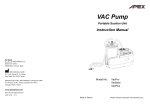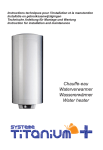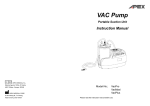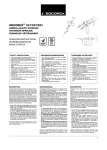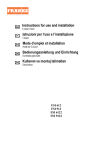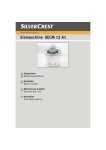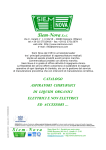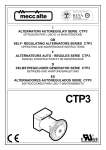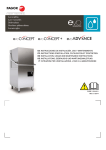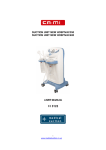Download Flovac multilingua CAMI 30751 015 ed 03 bozza del 21 09
Transcript
Collection liner for fluids suction canisters Poche de recueil pour bocaux pour fluides aspirés Flüssigkeitenabsaugbeutel Sacchetto per contenitore di fluidi aspirati Bolsa para el recipiente de succión de fluidos Instructions of use Mode d’emploi Gebrauchsanweisung Istruzioni per l’uso Instrucciones de uso Publ. code Code de Publication Kennzahl der Veröffentlichung Codice di Pubblicazione Código de Publicación 30751/015 Issue Édition du Auflage vom Edizione del Edición de 2010-09 0123 FLOVAC® is a trademark of FLOW METER S.p.A (03) K B M I L G H A E D P C F J Fig. 2 Fig. 1 N O P Fig. 4 Fig. 3 2 SUCTION CANISTER LINER Warning General information • • • • • WARNING: DANGER INDICATION Attention: Important indication ® Read this manual carefully before using the FLOVAC fluid suction system. AFTER UNPACKING, CHECK THAT THERE ARE NO PARTS MISSING OR DAMAGED. EACH TIME BEFORE USING THE DEVICE CARRY OUT THE OPERATIONS DESCRIBED IN THE CHAPTER “START-UP PROCEDURE”. The company will not accept any responsibility if these instructions are not observed. The medical device and its components or accessories do not contain parts in natural rubber latex. Connections • • • MAKE THE CONNECTIONS AND CHECK THE SEALS BETWEEN THE COMPONENTS AS DESCRIBED IN “INSTRUCTIONS FOR USE” SECTION. NON PERFORMANCE OF THESE CHECKS MAY COMPROMISE THE SAFETY AND FUNCTIONING OF THE DEVICE AND ANY CONNECTED ACCESSORIES (TUBES, PARTICLE CONTAINER, SUPPORT SYSTEMS, ETC). ANY SUCTION ADJUSTMENT DEVICE CONNECTED AND THE CONNECTION HOSES MUST COMPLY WITH EN ISO 10079-3 STANDARDS. INADVERTENT INVERSION OF THE CONNECTIONS COULD LEAD TO CONTAMINATION OF THE OPERATOR AND/OR OF THE VACUUM GENERATING SYSTEM. Operation • ® THE FLOVAC SUCTION LINERS MUST ALWAYS BE USED WITH CARE AND ONLY BY PERSONNEL WHO ARE AWARE OF THE CONSEQUENCES OF THE ONGOING THERAPY. • FULL CONTAINERS MUST BE HANDLED WITH GREAT CARE DURING TRANSFER TO THE DISPOSAL AREAS, FOLLOWING THE LOCAL PROCEDURES AND REGULATIONS. The device has been designed and manufactured in conformity with the safety regulations established by standard EN ISO 10079-3. Copyright © © Copyright FLOW METER S.P.A. 2003-2010 All right reserved. None of the information contained in this publication must be used for purposes other than the original ones. No part of this publication may be reproduced without written permission. CA-MI S.r.l. devices are subjected to periodic revisions to maintain and improve the production standards, functioning and increase their reliability. For this reason, the contents of this publication may be modified at any time without prior warning. The device described in this publication is designed and manufactured by CA-MI S.r.l., Via Ugo La Malfa, 31 – 43010 PILASTRO (PR) – Italy. GB 3 Applications ® The FLOVAC suction liner is used to collect organic fluids by aspiration and has been designed and manufactured for “High flow and high vacuum” applications (EN ISO 10079-3). It basically consists of a rigid supporting canister and of this disposable collection system, the latter formed by a liner bag hermetically welded to the lid. The lid has connectors that make it possible to connect the suction liner with the vacuum line and with the patient. A hydrophobic shut off and antibacterial filter protects the device and/or the vacuum system. This filter also operates as a an overflow valve, deactivating vacuum generation whenever the specified maximum filling limit is reached. The “PATIENT” port permits aspiration of fluids containing bone fragments once the right-angled reducing connector has been removed. A graduated scale printed on the external container makes it possible to monitor the volume of liquid collected. The size of the device to be used can be chosen on the basis of the real amount of fluid to be collected. Where a collection capacity greater than the maximum available is needed, the connector “TANDEM” can be employed. This permits connection of two or more equal devices to be joined in a stack, thus increasing the system’s collection capacity. The hermetic seal on the lid makes disposal particularly hygienic, simple and secure, for the patient and for the personnel dealing with the removal and disposal of the device. Instructions for use After connecting the “PATIENT” port to the suction tube and the “VACUUM” port to ® the vacuum line, the FLOVAC can be used for the safe and aseptic collection of organic fluids. Where specified, the patient connection tube and suction cannula are supplied with the container kit. Start-up procedure 1. Insert the liner bag (A) and, pressing firmly all around the edge, apply the lid (B) to the reusable rigid container of the appropriate dimensions (C) (supplied separately), making sure that the system is completely sealed. 2. Close the “TANDEM” (D) connector using the supplied tap (E) and pressing it firmly. 3. Position the device in the appropriate ring support (F) with the sliding connection device (G), ensuring that the system is vertical and firmly connected. 4. Connect the vacuum feed source to the “VACUUM” port (H) using a tube with suitable size and characteristics, ensuring that the butterfly connection (I) is fully inserted in the cover and turned to “ON”. when the canister is not in use, aspiration can be simply interrupted by turning the butterfly connector to “OFF”. 5. Connect a suitable patient tube (J) of appropriate dimensions and, if necessary, fitted with a cannula (K), to the “PATIENT” port (L) on the lid using, if necessary, the right-angled connector (M) supplied with the device. The “PATIENT” port permits aspiration of fluids containing bone fragments once the right-angled reducing connector has been removed. To prevent it from getting in the way, the tube may be easily attached to the support ring using the spring (P). 6. When the right-angled connector is used (M), ensure that it is firmly held in port (L). GB 4 Start-up procedure 7. Before use, check all the seals and make sure that there are no leaks by turning on the suction and blocking the cannula (K) connected to the “PATIENT” port (L). There are no leaks in the system it the liner bag is fully extended, closely adhering to the wall of the rigid container and the lid is slightly buckled towards the inside of the canister. 8. DO NOT USE A SOURCE OF VACUUM OF LESS THAN –750 mbar (-570 mmHg) WITH THIS CANISTER. 9. Turn on the suction and check regularly the level inside the canister. The vacuum check valve will interrupt suction if the fluid reaches the maximum level envisaged for the canister. 10. WHEN THE CHECK VALVE INTERVENES, IT IS NECESSARY TO DISCONNECT THE VACUUM WITHIN A MAXIMUM OF 5 MIN. 11. Proceed as described in the instructions given in the “Instructions for disposal” section. Use of several units in tandem 1. Fit the liner bags with the lids to all the canisters to be used, following the instructions given in point 1 of the previous paragraph. 2. Seal the “TANDEM” opening (D) on the last unit with the appropriate tap (E), pressing firmly. 3. Connect the vacuum feed source to the “VACUUM” port (H) of all units, using tubes with suitable size and characteristics and suitable line splitters (N) complete with exclusion taps (O). 4. Connect the “TANDEM” port (D) of the first unit to the “PATIENT” port (L) of the second unit, using the right angled connector (M) supplied with the kit. Continue for all other canisters, using tubes (P) with suitable size and characteristics (e.g. TANDEM tube Ø8x11 L=0.38m – FLOW METER Ref. 970010120). 5. Connect the patient tube (J), with suitable dimensions and characteristics and where necessary furnished with cannula (K), to “PATIENT” port (L) of the last canister, using if necessary the right angled connector (M) supplied with the kit. 6. Carry out all the checks described in points 6 and 7 of the previous section. 7. Start up suction and proceed as described in points 8, 9, 10 and 11 of the previous section. Use of the particle container 1. If necessary, a particle container can be fitted (FLOW METER ref. 000036100) to the FLOVAC device in order to hold the organic material necessary for laboratory analyses in a suitable containment bag. GB 5 Use of the particle container 2. After having fitted the bag with cover to the support container, following the instructions in the paragraph “Procedures for Use”, remove the right-angled connector (M) from the port (L). 3. Insert the particle container (Z) in the adapter (R), pressing the cover firmly down around its entire edge, ensuring that the system is completely sealed. Connect the device to the bag with cover, inserting it firmly in the port (L). 4. Connect the patient tube (J) with suitable dimensions and possibly equipped with a cannula (K) to the “PATIENT” port (S) of the cover, using if necessary the right angled connector (M) previously removed from the bag with cover. To avoid it causing an obstruction, the tube can be conveniently fixed to the support ring using the spring (P). 5. If the right-angled connector (M) is used, ensure that it is firmly inserted in its port (S). 6. Perform checks as described in points 6 and 7 of the paragraph “Procedures for Use”. 7. Initiate aspiration and proceed as described in points 8, 9, 10, and 11 of the paragraph “Procedures for Use”. Instructions for disposal 1. THE DEVICE IS INTENDED FOR SINGLE PATIENT APPLICATION. AVOID RE.USE IN ORDER TO LIMIT THE RISK OF CROSS CONTAMINATION. 2. TURN OFF THE VACUUM AND REMOVE ALL THE TUBES CONNECTED TO THE LINER, GIVING PARTICULAR ATTENTION TO AVOID ACCIDENTAL CONTAMINATION. IF RIGHT-ANGLED CONNECTOR HAS BEEN USED, THIS MUST BE REMOVED. 3. IF THE PARTICLE CONTAINER IS USED, IT MUST BE REMOVED IMMEDIATELY AFTER THE CONTAINER’S DEACTIVATION TO AVOID DEGRADATION OF THE COLLECTED PARTICLES. THEN CONNECT THE APPROPRIATE STOPPERS (U – V) TO THE “PATIENT” CONNECTORS (S) AND (T), PRESSING HARD, BEING CAREFUL TO AVOID ACCIDENTAL CONTAMINATION. TRANSFER THE SUITABLY IDENTIFIED DEVICE TO THE LABORATORY, AND AFTER HAVING OPENED THE PARTICLE CONTAINER AND CUT THE INTERNAL CONTAINMENT BAG (Q), RESPECTING THE HOSPITAL’S APPLICABLE REGULATIONS, THE ORGANIC MATERIAL TO BE ANALYSED CAN BE REMOVED. 4. FIT THE APPROPRIATE PLUGS (E – P) TO THE “PATIENT” (L) AND “TANDEM” (D) PORTS, PRESSING THEM HOME FIRMLY, TAKING CARE TO AVOID ACCIDENTAL CONTAMINATION. 5. Turn the butterfly connector (I) to “OFF”. 6. Remove the liner bag from the rigid container and transfer it to the waste disposal area, ensuring that all the openings are sealed, as well as any used tubes and cannulas, keeping in mind that the product is potentially infectious. 7. The product must be disposed of in accordance with the current hospital regulations. GB 6 Instructions for disposal 7. The reusable rigid canister must be cleaned and disinfected with water and neutral detergents and/or sterilised in an autoclave a 121 °C (relative pressure 1 bar) for 15 min. DO NOT USE SOLVENTS OR ALCOHOL FOR CLEANING AND DISINFECTION: THE USE OF THESE PRODUCTS MAY DAMAGE THE UNIT. The reusable canister mechanical resistance is guaranteed for 30 cleaning and sterilisation cycles under the specified conditions (EN ISO 10079-3). beyond this limit it may show signs of physical and mechanical damage to the plastic and its substitution is thus advised. Technical features Sales description .......................................... Reference code ............................................ “VACUUM” connector .................................. “PATIENT” connector................................... “TANDEM” connector................................... “TANDEM” tube (optional) .......................... Particle container (optional) ......................... Maximum vacuum value............................... Maximum flow value ..................................... Maximum graduation interval........................ Gradation precision ....................................... Patient tube dimensions............................... Vacuum tube dimensions ............................. Storage conditions ........................................ Working conditions ....................................... GB ® FLOVAC 31845 - 1.0 L 31846 - 2.0 L 31847 - 3.0 L 000036030 - 1.0 L with 1.8m tube Ø 8x11 000036031 - 2.0 L with 1.8m tube Ø 8x11 000036032 - 3.0 L with 1.8m tube Ø 8x11 000036050 - 1.0 L with 1.8m tube Ø 8x11 and vacuum stop 000036051 - 2.0 L with 1.8m tubo Ø 8x11 and vacuum stop 000036052 - 3.0 L with 1.8m tubo Ø 8x11 and vacuum stop 31840 - Reusable 1.0 L canister 31841 - Reusable 2.0 L canister 31842 - Reusable 3.0 L canister 970010120 - TANDEM tube 000036100 - Particle container Ø 9.0÷10.0 with ON-OFF switch Ø 14.0÷15.5 (Ø 8.0÷9.2 with right-angled connector) Ø 8.0÷9.2 Ø 8x11 L=0.38m “PATIENT” connector: Ø 14.0÷15.5 (Ø 8.0÷9.2 with right-angled connector) Outlet connector: Ø 14.0÷15.5 F. -750 mbar (-570 mmHg) 42 LPM under the recommended conditions 50 ml ±50 ml Min. Ø 6x9 (recommended Ø 8x11 L=2.5m max) Min. Ø 6x9 (recommended Ø 8x11 L=1.8m max) -40 °C ÷ +60 °C -18 °C ÷ +50 °C 7 POCHE DE RECUEIL D’ASPIRATION Avertissements AVERTISSEMENT: INDICATION DE DANGER Attention: Indication importante Information générales • • • • • Lire attentivement les informations figurant dans cette notice avant d'utiliser ® le système d'aspiration de liquides FLOVAC . APRES LE DEBALLAGE, IL EST NECESSAIRE DE VERIFIER L'INTEGRITE DU DISPOSITIF. AVANT CHAQUE UTILISATION, EFFECTUER LES OPERATIONS DECRITES DANS LE CHAPITRE “MODALITES D’UTILISATION”. La société décline toute responsabilité en cas de non-observation des présentes instructions. Le dispositif et ses parties composantes ou accessoires ne contiennent aucune partie en latex. Connexions • • • EFFECTUER LES RACCORDEMENTS ET LES CONTROLES D'ETANCHEITE DES COMPOSANTS SUIVANT LA DESCRIPTION DONNEE AU CHAPITRE "MODALITES D'UTILISATION". L’OMISSION DE CES CONTRÔLES PEUT NUIRE À LA SÉCURITÉ ET AU BON FONCTIONNEMENT DU DISPOSITIF ET DE SES ÉVENTUELS ACCESSOIRES (TUYAUX, SYSTÈME DE RÉCOLTE POUR PARTICULES, SYSTÈMES DE SUPPORT, ETC.). LES DISPOSITIFS DE REGLAGE DU VIDE EVENTUELLEMENT RACCORDES ET LES TUYAUX DE CONNEXION DOIVENT ETRE CONFORMES A LA NORME EN ISO 10079-3. UNE INVERSION FORTUITE DES RACCORDEMENTS PEUT CAUSER UNE CONTAMINATION DE L'OPERATEUR ET/OU DE L'INSTALLATION DE PRODUCTION DU VIDE. Opérations • ® LES BOCAUX DE RÉCOLTE DE LIQUIDES ASPIRES FLOVAC DOIVENT ETRE UTILISES AVEC ATTENTION ET SEULEMENT PAR DU PERSONNEL INFORME DES CONSEQUENCES DERIVANT DE LA THERAPIE EN COURS. • MANIPULER AVEC SOIN LES BOCAUX PLEINS DURANT LE TRANSPORT DANS LES ZONES DESTINEES A LA MISE AU REBUT, EN SUIVANT LES PROCEDURES EN VIGUEUR DANS L’HOPITAL. Le dispositif a été conçu et fabriqué pour satisfaire les critères de sécurité de la norme EN ISO 10079-3. Copyright © © Copyright FLOW METER S.P.A. 2003-2010 Tous droits réservés. Toutes les informations contenues dans la présente publication ne peuvent pas être utilisées dans d’autres buts que ceux qui en sont à l’origine. La publication ne peut pas être reproduite, ni partiellement nientièrement, sans accord écrit. Afin de maintenir et d’amèliorer les caractéristiques standard de production et de fonctionnement et d’agumenter la fiabilité, les dispositifs CA-MI S.r.l. sont régulièrement modernisés; c’est pourquoi que les contenus de cette publication sont sujets à des modifications sans préavis. Le dispositif décrit dans la présente publication est projeté et construit pour CA-MI S.r.l., Via Ugo La Malfa, 31 – 43010 PILASTRO (PR) – Italie. F 8 Applications ® Le dispositif FLOVAC est utilisé pour la récolte des fluides organiques aspirés et a été conçu et fabriqué pour applications de “Flux élevé et pour haut vide” (EN ISO 10079-3). Le dispositif est constitué essentiellement d'un bocal rigide de support et de ce système collecteur à usage unique composé d'une poche soudée hermétiquement au couvercle. Le couvercle est muni de raccords qui permettent le raccordement du bocal avec la ligne d'aspiration et avec le patient. Un filtre hydrophobe anti-reflux et anti-bactéries protège le dispositif et/ou l'installation de production du vide. Ce filtre sert aussi de vanne de trop plein en désactivant la production du vide si le niveau maximum de remplissage prévu a été atteint. L’ouverture “PATIENT” permet, une fois qu’a été enlevé le raccord de réduction à angle droit, d'effectuer l'aspiration de fluides contenant des fragments osseux. Une échelle graduée, imprimée sur l'extérieur du bocal, permet de contrôler le volume des liquides récoltés. Selon les nécessités effectives des volumes à aspirer, il est possible de choisir les dimensions du dispositif à utiliser. S’il est nécessaire d’avoir un système avec une capacité de récolte dépassant le volume maximum disponible, il est possible d’ajouter, grâce au raccord portant la mention “TANDEM”, deux dispositifs identiques en les mettant en cascade: on augmente ainsi la capacité de récolte du système. L'herméticité du couvercle rend particulièrement hygiénique, simple et sûre la phase de manipulation et élimination, tant pour le patient que pour le personnel préposé à l'enlèvement et au remplacement du dispositif proprement dit. Principe de fonctionnement Une fois que les ouvertures “PATIENT” et “VACUUM”® ont été raccordées respectivement au tuyau d'aspiration et à la ligne du vide, le système FLOVAC permet l'aspiration des fluides organiques de manière aseptique et sûre. Si cela est prévu, le tuyau de raccordement au patient et la canule d’aspiration sont fournis avec le bocal. Modalités d’utilisation 1. Introduire la poche (A) et appliquer le couvercle (B) sur le bocal (C) réutilisable de dimensions adéquates (fourni à part), en appuyant à fond sur tout le périmètre et en contrôlant que le système est hermétiquement fermé. 2. Fermer le raccord “TANDEM” (D) au moyen du bouchon (E) fourni en le pressant avec force. 3. Positionner le dispositif dans l’anneau de support (F) avec le dispositif d’accrochage à glissière (G), en vérifiant que le système est vertical et solidement fixé. 4. Raccorder la source d’alimentation du vide à l’ouverture “VACUUM” (H) à l’aide d’un tuyau ayant des dimensions et des caractéristiques adéquates, en vérifiant que le raccord papillon (I) est complètement inséré dans le couvercle et orienté en position ON. Quand le bocal n’est pas utilisé, il est possible d‘interrompre l’aspiration en tournant simplement le raccord papillon sur la position OFF. 5. Raccorder le tuyau côté patient (J), de dimensions et caractéristiques appropriées et éventuellement muni de canule (K), à l'ouverture “PATIENT” (L) du couvercle en employant, si nécessaire le raccord à angle droit (M) fourni avec le dispositif. L’ouverture “PATIENT” permet, une fois que le raccord de réduction à angle droit a été enlevé, d’aspirer des fluides contenant des fragments osseux. Pour que le tuyau ne gêne pas, il peut être facilement fixé par pression à l’anneau de support au moyen du ressort (P). 6. Si l’on utilise le raccord à angle droit (M), s’assurer qu’il est solidement inséré dans l’ouverture correspondante (L). F 9 Modalités d’utilisation 7. Avant d'utiliser le dispositif, contrôler toutes les fermetures et vérifier qu'il n'y a pas de fuites en mettant en marche la source d'aspiration et en bouchant la canule (K) raccordée à l'ouverture “PATIENT” (L). Si la poche se déploie à l'intérieur du bocal et adhère complètement à la paroi et si on observe une déformation du couvercle vers l'intérieur, cela signifie que le système ne présente pas de fuites. 8. NE PAS APPLIQUER AU DISPOSITIF UNE SOURCE DE VIDE INFERIEURE A 750 MBAR (-570 MMHG). 9. Commencer l'aspiration et contrôler périodiquement le niveau de remplissage du bocal. La valve du vide causera l'interruption de l'aspiration si les fluides aspirés ont atteint le niveau maximum de remplissage prévu pour le dispositif. 10. APRES L'INTERVENTION DE LA VALVE DE TROP PLEIN, IL FAUT DECONNECTER LA SOURCE D'ASPIRATION AU MAXIMUM DANS LES 5 MINUTES QUI SUIVENT. 11. Procéder suivant les instructions fournies dans le chapitre “Instructions pour la mise au rebut”. Utilisation en tandem avec plusieurs unités 1. Appliquer les poches avec couvercle à tous les bocaux à utiliser en suivant les instructions données au point 1 du paragraphe précédent. 2. Fermer hermétiquement l’ouverture “TANDEM” (D) de la dernière unité avec le bouchon (E) en le pressant avec force. 3. Raccorder la source d’alimentation du vide aux ouvertures “VACUUM” (H) de toutes les unités en utilisant des tuyaux ayant des dimensions et des caractéristiques adéquates et des dédoubleurs de ligne (N) appropriés avec robinets d’exclusion (O). 4. Raccorder l’ouverture “TANDEM” (D) de la première unité à l’ouverture “PATIENT” (L) de la deuxième unité, en utilisant pour ce faire le raccord à angle droit (M) fourni, et ainsi de suite pour tous les autres bocaux, au moyen de tuyaux (P) ayant des dimensions et des caractéristiques adéquates (par exemple tuyau TANDEM Ø8x11 L=0.38m – FLOW METER Ref. 970010120). 5. Raccorder le tuyau du patient (J), ayant des dimensions et des caractéristiques adéquates et éventuellement pourvu d’une canule (K), à l’ouverture “PATIENT” (L) du dernier couvercle en utilisant, le cas échéant, le raccord à angle droit (M) fourni. 6. Effectuer les contrôles selon les descriptions des points 6 et 7 du paragraphe précédent. 7. Commencer l'aspiration et procéder suivant les indications des points 8, 9, 10 et 11 du chapitre précédent. Utilisation du système de récolte pour particules 1. Si nécessaire, il est possible d’adapter au dispositif FLOVAC un système de récolte pour particules (FLOW METER Réf. 000036100) afin de retenir dans une maille la matière organique nécessaire pour les analyses de laboratoire. 2. Après avoir adapté le sachet avec couvercle au récipient de support, en suivant les instructions du paragraphe “Procédures d’utilisation”, enlever le raccord à angle droit (M) de l’ouverture (L). F 10 Utilisation du système de récolte pour particules 3. Assembler le système de récolte pour particules (Z) à l’adaptateur prévu à cet effet (R), en appuyant fort sur le couvercle sur tout le périmètre et en s’assurant que le système est complètement scellé, puis raccorder le dispositif au sachet avec couvercle en l’insérant solidement dans l’ouverture (L). 4. Raccorder le tuyau du patient (J), ayant des dimensions et des caractéristiques adéquates et éventuellement pourvu d’une canule (K), à l’ouverture “PATIENT” (S) du couvercle en utilisant, le cas échéant, le raccord à angle droit (M) précédemment enlevé du sachet avec couvercle. Pour qu’il ne gêne pas, ce tuyau peut être aisément fixé par pression à l’anneau de support au moyen d’un ressort (P). 5. Si l’on utilise le raccord à angle droit (M), s’assurer qu’il est solidement inséré dans l’ouverture correspondante (S). 6. Effectuer les contrôles décrits aux points 6 et 7 du paragraphe “Procédures d’utilisation”. 7. Commencer l’aspiration et suivre les instructions des points 8, 9, 10 et 11 du paragraphe “Procédures d’utilisation”. Instructions pour la mise au rebut 1. LE DISPOSITIF EST CONÇU POUR APPLICATION A UN SEUL PATIENT. EVITER DE LE REUTILISER POUR LIMITER LE RISQUE DE CONTAMINATION CROISEE. 2. DESACTIVER LA SOURCE D'ASPIRATION ET ENLEVER TOUS LES TUYAUX RACCORDÉS AU BOCAL EN FAISANT PARTICULIEREMENT ATTENTION A EVITER TOUTE CONTAMINATION ACCIDENTELLE. SI LE RACCORD A ANGLE DROIT A ETE UTILISE, IL EST NECESSAIRE DE L’ENLEVER. 3. SI ON A UTILISÉ LE SYSTÈME DE RÉCOLTE POUR PARTICULES, IL EST NÉCESSAIRE DE L’ENLEVER TOUT DE SUITE APRÈS LA DÉSACTIVATION DU BOCAL POUR ÉVITER LA DÉGRADATION DES PARTICULES RECUEILLIES. APPLIQUER LES BOUCHONS PRÉVUS (U – V) SUR LES RACCORDS « PATIENT » (S) ET (T), EN EXERÇANT UNE FORTE PRESSION ET EN VEILLANT TOUT PARTICULIÈREMENT À ÉVITER LES CONTAMINATIONS ACCIDENTELLES. ENSUITE, TRANSFÉRER LE DISPOSITIF, ADÉQUATEMENT IDENTIFIÉ, AU LABORATOIRE ET, APRÈS AVOIR OUVERT LE SYSTÈME DE RÉCOLTE POUR PARTICULES ET COUPÉ LA MAILLE INTERNE CONTENANT LES PARTICULES (Q) EN RESPECTANT LES NORMES EN VIGUEUR DANS L’HÔPITAL , IL SERA POSSIBLE DE PRÉLEVER LA MATIÈRE ORGANIQUE POUR LES ANALYSES. 4. APPLIQUER LES BOUCHONS PREVUS (E – P) A CET EFFET AUX RACCORDS, “PATIENT” (L) ET “TANDEM” (D) EN LES ENFONÇANT A FOND ET EN FAISANT PARTICULIEREMENT ATTENTION A EVITER TOUTE CONTAMINATION ACCIDENTELLE. Tourner le raccord papillon (I) sur la position OFF. 5. 6. Enlever la poche du bocal et la transporter dans la zone de collecte des déchets, avec toutes les ouvertures hermétiquement fermées ainsi que les éventuels tuyaux avec canules employés, en considérant que le produit est potentiellement infecté.ù 6. Mettre le produit au rebut en respectant les normes en vigueur dans l’hôpital. F 11 Instructions pour la mise au rebut 7. Le bocal rigide réutilisable peut être nettoyé et désinfecté avec de l’eau et des détergents neutres et/ou stérilisé dans un autoclave à 121 °C (pression relative 1 bar) pendant 15 min. NE PAS UTILISER DE SOLVANTS OU D'ALCOOL POUR LE LAVAGE ET LA DESINFECTION: L'UTILISATION DE CES PRODUITS PEUT ENDOMMAGER CE COMPOSANT. La resistance mecanique du bocal reutilisable est garantie jusqu'a 30 cycles de nettoyage et de sterilisation aux conditions specifiees (EN ISO 10079-3). au-dela de cette limite, les caracteristiques physiques et mecaniques de la matiere plastique peuvent se degrader et il est donc conseille de le remplacer. Caractéristiques techniques Description Commerciale............................. Codes de référence ..................................... ® FLOVAC 31845 - 1.0 L 31846 - 2.0 L 31847 - 3.0 L 000036030 - 1.0 L avec 1.8m tuyau Ø 8x11 000036031 - 2.0 L avec 1.8m tuyau Ø 8x11 000036032 - 3.0 L avec 1.8m tuyau Ø 8x11 000036050 - 1.0 L avec 1.8m tuyau Ø 8x11 et stop-vide (vacuum stop) 000036051 - 2.0 L avec 1.8m tuyau Ø 8x11 et stop-vide (vacuum stop) 000036052 - 3.0 L avec 1.8m tuyau Ø 8x11 et stop-vide (vacuum stop) 31840 - Canister réutilisable 1.0 L 31841 - Canister réutilisable 2.0 L 31842 - Canister réutilisable 3.0 L 970010120 - Tuyau TANDEM 000036100 - Système de récolte pour Raccord “VACUUM”..................................... particules Raccord “PATIENT” ..................................... Ø 9.0÷10.0 avec interrupteur ON-OFF Ø 14.0÷15.5 (Ø 8.0÷9.2 avec raccord à Raccord “TANDEM” ..................................... angle droit) Tuyau “TANDEM” (en option)...................... Ø 8.0÷9.2 Système de récolte pour particules (en Ø 8x11 L=0.38m option) ........................................................... Raccord “PATIENT”: Ø 14.0÷15.5 (Ø 8.0÷9.2 raccord à angle droit) Raccord de sortie: Ø 14.0÷15.5 F. Valeur maximum de vide ........................... -750 mbar (-570 mmHg) Valeur maximum de débit .......................... 42 LPM dans les conditions conseillées Intervalle maximum de la graduation ....... 50 ml Précision de la graduation ........................... ±50 ml Dimensions du tuyau du patient ............... Min. Ø 6x9 (conseillé Ø 8x11 L=2.5m max) Dimensions du tuyau d'alimentation......... Min. Ø 6x9 (conseillé Ø 8x11 L=1.8m max) Conditions de stockage .............................. -40 °C ÷ +60 °C Conditions d'emploi................................. -18 °C ÷ +50 °C F 12 ABSAUGBEUTEL Hinweis HINWEIS: GEFAHRENBEREICH Achtung: Wichtiger Hinweis Allgemeine Informationen • • • • • ® Vor der Anwendung des Absaugbehälters FLOVAC sind die Angaben des vorliegenden Dokuments aufmerksam zu lesen. ÜBERPRÜFEN SIE DAS GERÄT NACH DEM ENTFERNEN DER VERPACKUNG AUF EVENTUELLE FEHLER ODER SCHÄDEN. VOR JEDER INBETRIEBNAHME DES GERÄTS IST DEN ANGABEN DES KAPITELS “ANWENDUNG” FOLGE ZU LEISTEN. Der Hersteller kann unter keinen Umständen für Schäden, die auf das Nichtbeachten der vorliegenden Gebrauchsanleitung, zurückgehen haftbar gemacht werden. Das Medizinprodukt und seine Bestandteile und Zusatzgeräte enthalten keine Teile aus natürlichen Latex. Anschlüsse • • • DIE KONTROLLE DER ANSCHLÜSSE UND DICHTUNGEN DER EINZELNEN KOMPONENTEN SIND DEM KAPITEL “ANWENDUNG” FOLGEND DURCHZUFÜHREN. DURCH UNTERLASSEN DIESER KONTROLLEN KANN DIE SICHERHEIT UND DIE FUNKTIONALITÄT DER VORRICHTUNG, SOWIE DER EVENTUELL ANGESCHLOSSENEN ZUBEHÖRTEILE (SCHLÄUCHE, PARTIKELBEHÄLTER, TRAGESYSTEME, USW.) BEEINTRÄCHTIGT WERDEN. GEGEBENENFALLS ANGESCHLOSSENE VORRICHTUNGEN ZUR REGULIERUNG UND MESSUNG DES VAKUUMS UND DIE VERBINDUNGSSCHLÄUCHE HABEN DER VORSCHRIFT EN ISO 10079-3 ZU ENTSPRECHEN. EIN UNGEWOLLTES VERTAUSCHEN DER ANSCHLÜSSE KANN DIE SICHERHEIT DES BENUTZERS GEFÄHRDEN UND/ODER DIE VAKUUMANLAGE BESCHÄDIGEN. Arbeitsgänge • ® DIE ABSAUGBEUTEL FLOVAC DÜRFEN AUSSCHLIEßLICH MIT GRÖßTER SORGFALT UND VON PERSONEN, DIE MIT DER ABSAUGUNG VON PATIENTEN VERTAUT SIND, BENÜTZT WERDEN. • BEIM TRANSPORT DER VOLLEN BEHÄLTER ZU DEN ENTSORGUNGSSTELLEN HAT ÄUßERSTE VORSICHT ZU WALTEN UND DIE VON DER ZUSTÄNDIGEN BEHÖRDE VORGESCHRIEBENEN NORMEN HABEN AUSNAHMSLOS BEFOLGT ZU WERDEN. Das Gerät wurde den Sicherheitskriterien der Vorschrift EN ISO 10079-3 entsprechend entwickelt und hergestellt. Copyright © © Copyright FLOW METER S.P.A. 2003-2010 Alle Rechte vorbehalten. Sämtliche, in vorliegender Veröffentlichung enthaltenen Informationen haben ausnahmslos für den dafür bestimmten Zweck verwendet zu werden. Die auszugsweise oder gesamte Wiedergabe der Texte ist ohne schriftliche Genehmigung strengstens untersagt. Aus Gründen der Beibehaltung und Verbesserung des Produktionsstandard, der Funktionsweise und Zuverlässigkeit der Produkte behält sich die Firma CA-MI S.r.l. das Recht vor, den Inhalt der vorliegenden Veröffentlichung nach Belieben und ohne vorherige Ankündigung abzuändern. Die in vorliegender Veröffentlichung beschriebene Vorrichtung wurde von der Firma CA-MI S.r.l. Via Ugo La Malfa, 31 – 43010 PILASTRO (PR) – Italien entwickelt und hergestellt. D 13 Anwendungsbereich ® Das System FLOVAC dient zur Aufnahme organischer Flüssigkeiten und ist zur Anwendung mit Hohem Flüssigkeitfluss und Vakuum entwickelt und hergestellt (EN ISO 10079-3). Das Absaugsystem setzt sich grundsätzlich aus einem Außenbehälter und einem hermetisch am Deckel abgeschlossenem Beutel zusammen. Der Deckel verfügt über Verbinder, die den Anschluß des Behälters an die Absaugleitung und an den Patienten ermöglichen. Ein hydrophober Filter mit Rückström- und Bakterienschutz sichert das Gerät und/oder die Vakuumanlage ab. Dieser Filter fungiert außerdem als Überlaufventil, indem er die Vakuumerzeugung ausschaltet, sobald der maximal vorgesehene Füllpegel erreicht ist. Der “PATIENT”-Anschluss ermöglicht nach Entfernung des rechtwinkligen Reduzierverbinders die Ansaugung von Flüssigkeiten, die Knochensplitterrückstände enthalten. Eine auf den Behälter aufgedruckte Maßskala ermöglicht die Volumenkontrolle der abgesaugten Flüssigkeit. Je nach Wunsch stehen verschiedene Grössen zur Verfügung. Falls ein System gewünscht wird, das eine Sammelkapazität aufweist, die über das maximal verfügbare Volumen hinausgeht, können dank dem mit der Beschriftung “TANDEM” gekennzeichneten Verbinder zwei oder mehrere gleiche Vorrichtungen in Kaskadenschaltung angeordnet werden: auf diese Weise wird die Sammelfähigkeit des Systems erhöht. Die hermetische Abdichtung des Deckels garantiert sowohl den Patienten, als auch dem zur Entfernung oder zum Wechsel des Geräts befugten Personal ein Maximum an Hygiene und Sicherheit während der Entsorgungsphase. Funktionsprinzip Nach Anschluß der Ausgänge “PATIENT” an den® Saugschlauch und “VACUUM” an die Vakuumanlage, gewährleistet das System FLOVAC ein aseptisches und sicheres Absaugen der organischen Flüssigkeiten. Falls vorgesehen, werden der Verbindungsschlauch zum Patienten und die Saugkanüle zusammen mit dem Behälter geliefert. Anwendung 1. 2. 3. Den Beutel (A) einsetzen und den Deckel (B) auf den Außenbehälter (C) aufsetzen. Der Deckel sollte fest angedrückt werden. Der Außenbehälter ist wieder verwenbar. Versichern Sie sich, daß das gesammte System dicht ist. Den Verbinder “ TANDEM” (D) schließen, indem man den zur Ausstattung gehörenden Verschluss (E) verwendet und fest andrückt. Die Vorrichtung in dem entsprechenden Haltering (F) mit dem Kupplungsschlitten (G) anordnen und sich dabei vergewissern, dass das System senkrecht und einwandfrei befestigt ist.. 4. Die Vakuumzufuhr mit dem Anschluss “ VACUUM” (H) verbinden und dazu einen Schlauch mit den entsprechenden Abmessungen und Eigenschaften verwenden; sich dabei vergewissern, dass die Drosselverbindung (l) ganz im Deckel liegt und auf Stellung ON steht. Wird der Behälter nicht verwendet, kann die Ansaugung unterbrochen werden, indem man die Drossel einfach auf OFF stellt. 5. Den Schlauch (J) zum Patienten an den Ausgang “ PATIENT” (L) des Deckels anschließen. Verwenden Sie dazu einen Schlauch (eventuell mit Kanüle (K)) mit entsprechenden Ausmaßen und Eigenschaften, sowie falls nötig das mitgelieferte, rechtwinkelige Verbindungsstück (M). Der “ PATIENT” -Anschluss ermöglicht die Ansaugung von Flüssigkeiten mit Knochensplitterrückständen nach Entfernung des rechtwinkligen Reduzierverbinders. Um zu vermeiden, dass er hinderlich wird, kann der Schlauch mit Hilfe der Feder (P) per Druck bequem am Haltering befestigt werden. Wird der rechtwinklige Verbinder (M) verwendet, muss sichergestellt werden, dass er fest in den entsprechenden Anschluss (L) eingesetzt ist. 6. D 14 Anwendung 7. Bevor das Gerät erstmalig in Betrieb genommen wird, sollte dieses hinsichtlich seiner Dichtheit kontrolliert werden. Schalten Sie dazu die Sauganlage ein und verschließen Sie die an den Ausgang “PATIENT” (L) angeschlossene Kanüle (K). Die Dichtheit des Systems ist dann gewährleistet, sobald der Beutel rundum am starren Behälter anliegt und der Deckel eine Wölbung in Richtung Behälterinnenraum aufweist. 8. DEN ABSAUGBEUTEL NICHT AN EINE VAKUUMANLAGE MIT EINEM SOG DER GERINGER ALS -750 mbar (-570 mm Hg) IST ANSCHLIESSEN. 9. Mit dem Absaugen beginnen und den Füllstand des Behälters in regelmäßigen Abständen überprüfen. Erreicht die abgesaugte Flüssigkeit den für das Gerät höchstzulässigen Füllstand, unterbricht der Überlaufschutz der Vakuumanlage den Absaugvorgang. 10. WURDE DER ÜBERLAUFSCHUTZ AUSGELÖST, MUß DIE SAUGANLAGE INNERHALB VON 5 MIN. ABGESCHALTET WERDEN. 11. Gemäß den Angaben unter Kapitel “Hinweise zur Entsorgung” fortfahren. Tandemfunktion mit mehr als einem Gerät 1. Setzen Sie nun Beutel samt Deckel, den Angaben unter Punkt 1 folgend, auf alle zu verwendenden Behälter. 2. Die Öffnung “TANDEM” (D) der letzten Einheit mit dem entsprechenden Verschluss (E) versiegeln und ihn fest andrücken. 3. Die Vakuumzufuhr mit den “VACUUM”-Anschlüssen (H) sämtlicher Einheiten verbinden und dabei Schläuche mit geeigneten Abmessungen und Eigenschaften sowie entsprechende Leitungsverdoppler (N), komplett mit Sperrhähnen (O), verwenden. 4. Die “TANDEM”-Öffnung (D) der ersten Einheit mit der “ PATIENT” -Öffnung (L) der zweiten Einheit verbinden und zu diesem Zweck den zur Ausstattung gehörenden rechtwinkligen Verbinder (M) verwenden, und so bei allen übrigen Behältern verfahren, wobei man jeweils Schläuche (P) mit geeigneten Abmessungen und Eigenschaften verwendet (zum Beispiel TANDEM-Schlauch Ø8x11 L=0.38 – FLOW METER Ref. 970010120). 5. Den Patientenschlauch (J), der entsprechende Abmessungen und Eigenschaften aufweisen und eventuell mit einer Kanüle (K) ausgerüstet sein muss, mit dem “ PATIENT” -Anschluss (L) des letzten Deckels verbinden, wobei falls erforderlich der zur Ausstattung gehörende rechtwinklige Verbinder (M) verwendet wird. 6. Führen Sie nun die unter Punkt 6 und 7 des vorangehenden Kapitels angeführten Kontrollen aus. 7. Mit dem Absaugvorgang beginnen und, wie unter den Punkten 8, 9, 10 und 11 des vorangehenden Kapitels angeführt, fortfahren. Gebrauch des Partikelbehälters 1. Im Bedarfsfall kann an die Vorrichtung FLOVAC ein Partikelbehälter angepasst werden (FLOW METER Art. Nr. 000036100), um das für die Laboruntersuchungen erforderliche organische Material in einem Geflecht zurückzuhalten. D 15 Gebrauch des Partikelbehälters 2. Nachdem der Beutel mit Deckel wie im Abschnitt "Gebrauchsanleitungen" beschrieben an den Tragebehälter angepasst wurde, den rechtwinkligen Verbinder (M) vom Anschluss (L) entfernen. 3. Den Partikelbehälter (Z) in den entsprechenden Adapter (R) stecken, dabei den Deckel rundum fest andrücken und sicherstellen, dass das ganze System dicht geschlossen ist; anschließend die Vorrichtung am Beutel mit Deckel anschließen und fest in den Anschluss (L) stecken. 4. Den Patientenschlauch (J), der entsprechende Abmessungen und Eigenschaften aufweisen und eventuell mit einer Kanüle (K) ausgerüstet sein muss, mit dem "PATIENT"-Anschluss (S) des Deckels verbinden, wobei falls erforderlich rechtwinklige Verbinder (M) zu verwenden ist, der zuvor vom Beutel mit Deckel entfernt wurde. Um zu vermeiden, dass er hinderlich wird, kann der Schlauch mit Hilfe der Feder (P) per Druck bequem am Haltering befestigt werden. 5. Wird der rechtwinklige Verbinder (M) verwendet, muss sichergestellt werden, dass er fest in den entsprechenden Anschluss (S) eingesetzt ist. 6. Die Kontrollen wie unter Punkt 6 und 7 des Abschnitts “Gebrauchsanleitungen” beschrieben durchführen. 7. Die Ansaugung beginnen und wie unter den Punkten 8, 9, 10 und 11 des Abschnitts “Gebrauchsanleitungen” beschrieben vorgehen. Hinweise zur Entsorgung 1. DAS GERÄT IST ZUM EINZELPATIENTENGEBRAUCH HERGESTELLT. DAS WIEDERGEBRAUCH MUSS VERHINDERT WERDEN, UM KONTAMINATIONS RISIKO ZU HINDERN. 2. DIE SAUGANLAGE ABSCHALTEN UND SÄMTLICHE AM BEHÄLTER ANGESCHLOSSENEN SCHLÄUCHE ENTFERNEN. DABEI IST BESONDERS DARAUF ZU ACHTEN, KEINE UNGEWOLLTEN VERUNREINIGUNGEN ZU VERURSACHEN. FALLS DER RECHTWINKLIGE VERBINDER VERWENDET WURDE, MUSS ER ENTFERNT WERDEN. 3. FALLS DER PARTIKELBEHÄLTER BENUTZT WURDE, MUSS ER SOFORT NACH DEAKTIVIERUNG DES BEHÄLTERS ENTFERNT WERDEN, DAMIT DIE GESAMMELTEN PARTIKEL NICHT VERDERBEN. DANN DIE DECKEL (U – V) AN DEN “PATIENT”-VERBINDERN (S) UND (T) AUFSETZEN; DABEI FEST ZUDRÜCKEN UND JEDE KONTAMINATION UNBEDINGT VERMEIDEN. ANSCHLIESSEND DIE ZWECKMÄSSIG GEKENNZEICHNETE VORRICHTUNG AN DAS LABOR WEITERLEITEN. NACHDEM DER PARTIKELBEHÄLTER GEÖFFNET UND DAS GEFLECHT IM INNERN (Q) UNTER BEFOLGUNG DER IM KRANKENHAUS GELTENDEN VORSCHRIFTEN AUFGESCHNITTEN WURDE, KANN DAS ORGANISCHE MATERIAL FÜR DIE UNTERSUCHUNG ENTNOMMEN WERDEN. 4. DIE PFROPFEN (E – P) AUF DIE VERBINDER “PATIENT” (L) UND “TANDEM” (D) AUFDRÜCKEN, WOBEI DARAUF ZU ACHTEN IST, DAß KEINE FLÜSSIGKEIT AUSLÄUFT. Die Drossel (l) auf OFF stellen. 5. 6. Den Beutel aus dem Außenbehälter nehmen und zur Entsorgungsstelle bringen. Dabei müssen sämtliche Öffnungen einwandfrei verschlossen werden. Beim Transport der bereits verwendeten Beutel und Schläuche (inklusive eventueller Kanülen) ist zu bedenken, daß der Inhalt - und damit auch die einzelnen Komponenten - infektiös sein könnten. D 16 Hinweise zur Entsorgung 7. Das Produkt unter Berücksichtigung der im Krankenhaus geltenden Vorschriften entsorgen. 8. Der steife, wieder verwendbare Behälter kann mit Wasser und neutralen Reinigungsmitteln gereinigt und/oder bei 121°C (rel ativer Druck 1 bar) 15 Minuten lang im Druckkessel desinfiziert werden. VERWENDEN SIE BEIM REINIGEN ODER DESINFIZIEREN DES BEHÄLTERS UNTER KEINEN UMSTÄNDEN ALKOHOL ODER LÖSUNGSMITTEL: DIESE PRODUKTE KÖNNTEN DAS GERÄT UNWIDERRUFLICH BESCHÄDIGEN. Die mechanische Festigkeit des wieder verwendbaren Behälters wird für bis zu 30 Reinigungs- und Sterilisationszyklen unter den angegebenen Verhältnissen (EN ISO 10079-3) garantiert. Über diese Grenze hinaus kann Verfall der physikalisch-mechanischen Eigenschaften des Kunststoffmaterials eintreten, weswegen eine entsprechende Auswechslung empfohlen wird. Technische Eigenschaften Handelsübliche Beschreibung ..................... Artikelnummer ............................................. Verbinder “VACUUM”.................................. Verbinder “PATIENT” .................................. Verbinder “TANDEM” .................................. Schlauch “TANDEM” (Option) ..................... Partikelbehälter (Option) .............................. Höchstzulässiger Vakuumwert................ Maximale Leistung .................................. Maximaler Abstand der Gradunterteilung ..... Gradteilungs-Präzision.................................... Ausmaße des Schlauchs “Patient”.......... Ausmaße des Vakuumanschluß ............. Lagerbedingungen ...................................... Betriebsbedingungen .............................. D ® FLOVAC 31845 - 1.0 L 31846 - 2.0 L 31847 - 3.0 L 000036030 - 1.0 L mit 1.8m Schlauch Ø 8x11 000036031 - 2.0 L mit 1.8m Schlauch Ø 8x11 000036032 - 3.0 L mit 1.8m Schlauch Ø 8x11 000036050 - 1.0 L mit 1.8m Schlauch Ø 8x11 und vacuum stop 000036051 - 2.0 L mit 1.8m Schlauch Ø 8x11 und vacuum stop 000036052 - 3.0 L mit 1.8m Schlauch Ø 8x11 und vacuum stop 31840 - wieder verwendbarer Kanister 1.0 L 31841 - wieder verwendbarer Kanister 2.0 L 31842 - wieder verwendbarer Kanister 3.0 L 970010120 – TANDEM - Schlauch 000036100 - Partikelbehälter Ø 9.0÷10.0 mit ON-OFF-Schalter Ø 14.0÷15.5 (Ø 8.0÷9.2 mit rechtwinkeligem Verbindungsstück) Ø 8.0÷9.2 Ø 8x11 L=0.38m “PATIENT” – Verbinder Ø 14.0÷15.5 (Ø 8.0÷9.2 mit rechtwinkeligem Verbindungsstück) Ausagangsverbinder: Ø 14.0÷15.5 F. -750 mbar (-570 mmHg) 42 liter pro Minute unter den angeführten Bedingungen 50 ml ±50 ml Min. Ø 6x9 (empfohlen Ø 8x11 L=2.5m max) Min. Ø 6x9 (empfohlen Ø 8x11 L=1.8m max) -40 °C ÷ +60 °C -18 °C ÷ +50 °C 17 SACCHETTO PER CONTENITORE DI FLUIDI ASPIRATI Avvertenze AVVERTENZA: INDICAZIONE DI PERICOLO Attenzione : Indicazione importante Informazioni generali • • • • • Leggere attentamente le informazioni riportate in questo documento prima di ® utilizzare il sistema di raccolta per fluidi aspirati FLOVAC . DOPO IL DISIMBALLO È NECESSARIO VERIFICARE L’INTEGRITÀ DEL DISPOSITIVO. ESEGUIRE PRIMA DI OGNI IMPIEGO LE OPERAZIONI RIPORTATE NEL CAPITOLO “PROCEDURE DI UTILIZZO”. La società declina ogni responsabilità derivata da inosservanza delle presenti istruzioni d’uso. Il dispositivo medico e le sue parti componenti o accessorie non contengono particolari in latice naturale. Connessioni • • • EFFETTUARE I COLLEGAMENTI ED I CONTROLLI DI TENUTA DEI COMPONENTI COME DESCRITTO NEL CAPITOLO “PROCEDURE DI UTILIZZO”. L’OMISSIONE DI TALI CONTROLLI PUÒ COMPROMETTERE LA SICUREZZA E LA FUNZIONALITÀ DEL DISPOSITIVO E DEGLI EVENTUALI ACCESSORI CONNESSI (TUBI, CONTENITORE PARTICELLARE, SISTEMI DI SUPPORTO, ECC). I DISPOSITIVI DI REGOLAZIONE DEL VUOTO EVENTUALMENTE COLLEGATI ED I TUBI DI CONNESSIONE, DEVONO ESSERE CONFORMI ALLA NORMATIVA EN ISO 10079-3. UNA CASUALE INVERSIONE DELLE CONNESSIONI, PUÓ CAUSARE CONTAMINAZIONE DELL’OPERATORE E/O DELL’IMPIANTO DI GENERAZIONE DEL VUOTO. Operazioni • ® I CONTENITORI DI RACCOLTA PER LIQUIDI ASPIRATI FLOVAC DEVONO ESSERE IMPIEGATI CON ATTENZIONE E SOLO DA PERSONALE CHE SIA A CONOSCENZA DELLE CONSEGUENZE DERIVANTI DALLA TERAPIA IN ATTO. • MANEGGIARE SCRUPOLOSAMENTE I CONTENITORI PIENI DURANTE IL TRASPORTO NELLE AREE DESTINATE ALLO SMALTIMENTO, SEGUENDO LE PROCEDURE IN VIGORE PRESSO L'ENTE. Il dispositivo è stato progettato e costruito per soddisfare i criteri di sicurezza della normativa EN ISO 10079-3. Copyright © Copyright© FLOW METER S.p.A. 2003-2010 Tutti i diritti riservati. Tutte le informazioni contenute nella presente pubblicazione non possono essere usate per scopi diversi da quelli originari. La pubblicazione non può essere riprodotta in parte o interamente senza consenso scritto. Al fine di mantenere e migliorare gli standard di produzione, il funzionamento ed aumentare l’affidabilità, i dispositivi CA-MI S.r.l. sono aggiornati periodicamente; per questa ragione, i contenuti di questa pubblicazione sono soggetti a modifica senza avviso preventivo. Il dispositivo descritto nella presente pubblicazione è progettato e costruito da CA-MI S.r.l., Via Ugo La Malfa, 31 – 43010 PILASTRO (PR) – Italia. I 18 Applicazioni Il dispositivo FLOVAC® viene utilizzato per la raccolta dei fluidi organici in aspirazione ed è stato progettato e costruito per applicazioni di “Alto flusso ed alto vuoto” (EN ISO 10079-3). É costituito essenzialmente da un contenitore rigido di supporto e dal sistema di raccolta ad uso singolo, quest’ultimo realizzato da una sacca saldata ermeticamente al coperchio. Il coperchio è dotato di connettori che consentono il collegamento del contenitore di raccolta con la linea di aspirazione e con il paziente. Un filtro idrofobico antiriflusso ed antibatterico protegge l’apparecchiatura e/o l’impianto di generazione del vuoto. Tale filtro svolge inoltre la funzione di valvola di troppo pieno disattivando la generazione del vuoto qualora sia stato raggiunto il livello massimo previsto di riempimento. La porta “PATIENT” permette, una volta rimosso il connettore di riduzione ad angolo retto, di effettuare aspirazioni di fluidi contenenti frustuli ossei. Una scala graduata, stampata sul contenitore esterno, consente il monitoraggio del volume dei liquidi raccolti. In funzione delle effettive necessità dei volumi da aspirare, è possibile scegliere le dimensioni del dispositivo da utilizzare. Qualora si debba avere un sistema con capacità di raccolta eccedente il volume massimo disponibile, è possibile abbinare, grazie al connettore contraddistinto dalla dicitura “TANDEM”, due o più dispositivi uguali ponendoli in cascata: in tale modo viene aumentata la capacità di raccolta del sistema. La tenuta ermetica del coperchio rende particolarmente igienica, semplice e sicura la fase di smaltimento, sia per il paziente, sia per il personale addetto alla rimozione o sostituzione del dispositivo stesso. Principio di funzionamento Una volta collegate le porte “PATIENT” al tubo di aspirazione e “VACUUM” alla linea di vuoto, il ® sistema FLOVAC consente la raccolta dei fluidi organici in modo asettico e sicuro. Qualora previsto, il tubo di collegamento al paziente e la cannula di aspirazione vengono fornite a corredo del contenitore. Procedure di utilizzo 1. Inserire il sacchetto (A) ed applicare, premendo fermamente su tutto il perimetro, il coperchio (B) al contenitore rigido riutilizzabile di dimensioni adeguate (C) (fornito a parte), assicurandosi che il sistema sia sigillato completamente. 2. Chiudere il connettore “TANDEM” (D) utilizzando il tappo (E) in dotazione e pressandolo con forza. 3. Posizionare il dispositivo nell’apposito anello di supporto (F) con dispositivo di aggancio a slitta (G), verificando che il sistema risulti verticale e saldamente fissato. 4. Collegare la fonte di alimentazione del vuoto alla porta “VACUUM” (H) utilizzando un tubo avente dimensioni e caratteristiche idonee, verificando che il raccordo a farfalla (I) sia completamente inserito nel coperchio e orientato nella posizione ON. Quando il contenitore non è in uso è possibile interrompere l’aspirazione semplicemente ruotando il raccordo a farfalla sulla posizione OFF. 5. Connettere il tubo paziente (J), avente dimensioni e caratteristiche adeguate ed eventualmente dotato di cannula (K), alla porta “PATIENT” (L) del coperchio impiegando, se del caso, il connettore ad angolo retto (M) fornito a corredo. La porta “PATIENT” permette, una volta rimosso il connettore di riduzione ad angolo retto, di effettuare aspirazioni di fluidi contenenti frustuli ossei. Per impedire di essere d’intralcio, tale tubo può essere comodamente fissato a pressione all’anello di supporto mediante la molla (P). Nel caso in cui venga usato il connettore ad angolo retto (M), assicurarsi che sia inserito saldamente nella relativa porta (L). 6. I 19 Procedure di utilizzo 7. Prima di procedere all’utilizzo, controllare tutte le chiusure e verificare che non vi siano perdite avviando la fonte di aspirazione ed occludendo la cannula (K) collegata all’apertura “PATIENT” (L). Se si osserva la distensione del sacchetto sino ad aderire completamente alla parete del contenitore rigido ed un ripiegamento del coperchio verso l’interno di tale bicchiere, il sistema non presenta perdite. 8. NON APPLICARE AL CONTENITORE UNA FONTE DI VUOTO INFERIORE A -750 mbar (-570 mm Hg). 9. Iniziare l’aspirazione e controllare periodicamente il livello di riempimento del contenitore. La valvola di arresto del vuoto causerà l’interruzione dell’aspirazione qualora i fluidi aspirati abbiamo raggiunto il massimo livello di riempimento previsto per il dispositivo. 10. DOPO L’INTERVENTO DELLA VALVOLA DI TROPPO PIENO È NECESSARIO SCOLLEGARE LA FONTE DI ASPIRAZIONE ENTRO UN PERIODO NON SUPERIORE A 5 MIN. 11. Procedere in accordo alle istruzioni fornite dal capitolo “Istruzioni per lo smaltimento”. Utilizzo in tandem con più unità 1. Applicare i sacchetti con coperchio a tutti i contenitori da usare seguendo le istruzioni descritte al punto 1 del paragrafo precedente. 2. Sigillare l’apertura “TANDEM” (D) dell’ultima unità con l’apposito tappo (E), pressandolo con forza. 3. Collegare la fonte di alimentazione del vuoto alle porte “VACUUM” (H) di tutte le unità utilizzando tubi aventi dimensioni e caratteristiche idonee ed adeguati sdoppiatori di linea (N) completi di rubinetti di esclusione (O). 4. Collegare l’apertura “TANDEM” (D) della prima unità all’apertura “PATIENT”(L) della seconda unità, impiegando a tale proposito il connettore ad angolo retto (M) fornito a corredo, e così via per tutti gli altri contenitori, utilizzando tubi (P) di dimensioni e caratteristiche idonee (ad esempio tubo TANDEM Ø8x11 L=0.38m – FLOW METER Ref. 970010120). 5. Connettere il tubo paziente (J), avente dimensioni e caratteristiche adeguate ed eventualmente dotato di cannula (K), alla porta “PATIENT” (L) dell’ultimo coperchio impiegando, se del caso, il connettore ad angolo retto (M) fornito a corredo. 6. Effettuare i controlli come descritto al punto 6 e 7 del paragrafo precedente. 7. Iniziare l’aspirazione e procedere come descritto ai punti 8, 9, 10 e 11 del paragrafo precedente. Utilizzo del contenitore particellare 1. Qualora necessario, è possibile adattare al dispositivo FLOVAC un contenitore particellare (FLOW METER Ref. 000036100) al fine di trattenere in un’apposita calza il materiale organico necessario per le analisi di laboratorio. 2. Dopo aver adattato il sacchetto con coperchio al contenitore di supporto, seguendo le istruzioni riportate nel paragrafo “Procedure di Utilizzo” togliere il connettore ad angolo retto (M) dalla porta (L). I 20 Utilizzo del contenitore particellare 3. Inserire il contenitore particellare (Z) nell’apposito adattatore (R), premendo fermamente il coperchio su tutto il perimetro, assicurandosi che il sistema sia sigillato completamente; connettere quindi il dispositivo al sacchetto con coperchio, inserendolo saldamente nella porta (L). 4. Connettere il tubo paziente (J), avente dimensioni e caratteristiche adeguate ed eventualmente dotato di cannula (K), alla porta “PATIENT” (S) del coperchio impiegando, se del caso, il connettore ad angolo retto (M) precedentemente rimosso dal sacchetto con coperchio. Per impedire di essere d’intralcio, tale tubo può essere comodamente fissato a pressione all’anello di supporto mediante la molla (P). 5. Nel caso in cui venga usato il connettore ad angolo retto (M), assicurarsi che sia inserito saldamente nella relativa porta (S). 6. Effettuare i controlli come descritto al punto 6 e 7 del paragrafo “Procedure di Utilizzo”. 7. Iniziare l’aspirazione e procedere come descritto ai punti 8, 9, 10 e 11 del paragrafo “Procedure di Utilizzo”. Istruzioni per lo smaltimento 1. IL DISPOSITIVO E’ PROGETTATO PER APPLICAZIONI SU SINGOLO PAZIENTE. EVITARNE IL RIUTILIZZO IN MODO DA LIMITARE IL RISCHIO DI CONTAMINAZIONI CROCIATE. 2. DISATTIVARE LA SORGENTE DI ASPIRAZIONE E RIMUOVERE TUTTI I TUBI CONNESSI AL CONTENITORE, PONENDO PARTICOLARE ATTENZIONE AD EVITARE CONTAMINAZIONI ACCIDENTALI. QUALORA FOSSE STATO IMPIEGATO IL CONNETTORIE AD ANGOLO RETTO, È NECESSARIO RIMUOVERLO. 3. QUALORA FOSSE STATO IMPIEGATO IL CONTENITORE PARTICELLARE, È NECESSARIO RIMUOVERLO SUBITO DOPO LA DISATTIVAZIONE DEL CONTENITORE, PER EVITARE IL DEGRADO DELLE PARTICELLE RACCOLTE. APPLICARE QUINDI GLI APPOSITI TAPPI (U – V) AI CONNETTORI “PATIENT” (S) E (T), PRESSANDOLI CON FORZA, PONENDO PARTICOLARE ATTENZIONE AD EVITARE CONTAMINAZIONI ACCIDENTALI. TRASFERIRE QUINDI IL DISPOSITIVO, OPPORTUNAMENTE IDENTIFICATO, AL LABORATORIO E, DOPO AVER APERTO IL CONTENITORE PARTICELLARE E TAGLIATO LA CALZA DI CONTENIMENTO INTERNA (Q) RISPETTANDO LE NORME IN VIGORE PRESSO L’OSPEDALE, SARÁ POSSIBILE PRELEVARE IL MATERIALE ORGANICO PER LE ANALISI. 4. APPLICARE GLI APPOSITI TAPPI (E – P) AI CONNETTORI “PATIENT” (L) E “TANDEM” (D) DEL SACCHETTO CON COPERCHIO, PRESSANDOLI CON FORZA, PONENDO PARTICOLARE ATTENZIONE AD EVITARE CONTAMINAZIONI ACCIDENTALI. 5. Ruotare il raccordo a farfalla (I) in posizione OFF. 6. Rimuovere il sacchetto dal contenitore rigido e trasportarlo nell’area di raccolta rifiuti, con tutte le aperture sigillate, e gli eventuali tubi con cannula impiegati, considerando che il prodotto è potenzialmente infetto. 7. Gettare il prodotto rispettando le norme in vigore presso l’ospedale. 8. Il contenitore rigido riutilizzabile può essere pulito e disinfettato utilizzando acqua e detergenti neutri e/o sterilizzato in autoclave a 121 °C (pressione relativa 1 bar) per 15 min. NON USARE SOLVENTI O ALCOOL PER LA PULIZIA E LA DISINFEZIONE: L'IMPIEGO DI QUESTI PRODOTTI PUÒ DANNEGGIARE IL COMPONENTE. La resistenza meccanica del contenitore riutilizzabile viene garantita fino a 30 cicli di pulizia e sterilizzazione alle condizioni specificate (EN ISO 10079-3). Oltre questo limite possono manifestarsi decadimenti delle caratteristiche fisico-meccaniche della materia plastica e pertanto è consigliata la sostituzione. I 21 Caratteristiche tecniche Descrizione Commerciale ................................ Codici di riferimento .......................................... Connettore “VACUUM” .................................... Connettore “PATIENT” ..................................... Connettore “TANDEM”..................................... Tubo “TANDEM” (opzionale) ........................... Contenitore particellare (opzionale)................. Valore massimo di vuoto.................................. Valore massimo di portata ............................... Intervallo massimo della graduazione ............. Accuratezza della graduazione........................ Dimensioni del tubo paziente........................... Dimensioni del tubo di alimentazione .............. Condizioni di conservazione ............................ Condizioni operative ......................................... I ® FLOVAC 31845 - 1.0 L 31846 - 2.0 L 31847 - 3.0 L 000036030 - 1.0 L con 1.8m tubo Ø 8x11 000036031 - 2.0 L con 1.8m tubo Ø 8x11 000036032 - 3.0 L con 1.8m tubo Ø 8x11 000036050 - 1.0 L con 1.8m tubo Ø 8x11 e vacuum stop 000036051 - 2.0 L con 1.8m tubo Ø 8x11 e vacuum stop 000036052 - 3.0 L con 1.8m tubo Ø 8x11 e vacuum stop 31840 - Canister riutilizzabile 1.0 L 31841 - Canister riutilizzabile 2.0 L 31842 - Canister riutilizzabile 3.0 L 970010120 - Tubo TANDEM 000036100 - Contenitore particellare Ø 9.0÷10.0 con interruttore ON-OFF Ø 14.0÷15.5 (Ø 8.0÷9.2 con connettore ad angolo) Ø 8.0÷9.2 Ø 8x11 L=0.38m Connettore “PATIENT”: Ø 14.0÷15.5 (Ø 8.0÷9.2 con connettore ad angolo) Connettore di uscita: Ø 14.0÷15.5 F. -750 mbar (-570 mm Hg) 42 LPM nelle condizioni consigliate 50 ml ±50 ml Min. Ø 6x9 (consigliato Ø 8x11 L=2.5m max) Min. Ø 6x9 (consigliato Ø 8x11 L=1.8m max) -40 °C ÷ +60 °C -18 °C ÷ +50 °C 22 BOLSA PARA EL RECIPIENTE DE SUCCIÓN Advertencias ADVERTENCIA: INDICACIÓN DE PELIGRO Atencióne: Indicación importante Informaciones generales • • • • • Leer atentamente las instrucciones antes de utilizar el sistema de succión ® desechable FLOVAC . UNA VEZ DESEMBALADO, COMPROBAR QUE EL EQUIPO ESTÁ EN PERFECTAS CONDICIONES. CADA VEZ QUE VAYA A UTILIZARSE, DEBEN EFECTUARSE ANTES LAS OPERACIONES INDICADAS EN EL CAPÍTULO “MODO DE EMPLEO”. La sociedad declina cualquier responsabilidad derivada de la inobservancia de estas instrucciones de utilización. El producto sanitario y sus componentes o accesorios no contienen partes en látex de caucho natural. Conexiones • • • EFECTUAR LAS CONEXIONES Y LOS CONTROLES DE HERMETICIDAD DE LOS COMPONENTES TAL Y COMO SE DESCRIBE EN EL CAPÍTULO “MODO DE EMPLEO”. LA OMISIÓN DE DICHOS CONTROLES PUEDE COMPROMETER LA SEGURIDAD Y LA FUNCIONALIDAD DEL DISPOSITIVO Y DE LOS EVENTUALES ACCESORIOS CONECTADOS (TUBOS, CONTENEDOR DE PARTÍCULAS, SISTEMAS DE SOPORTE, ETC). LOS EQUIPOS DE REGULACIÓN DEL VACÍO EVENTUALMENTE CONECTADOS Y LOS TUBOS DE CONEXION, TIENEN QUE RESPETAR LAS NORMAS EN ISO 10079-3. UNA INVERSIÓN CASUAL DE LAS CONEXIONES, PODRÍA CAUSAR LA CONTAMINACIÓN DEL OPERADOR Y/O DE LA INSTALACIÓN DE GENERACIÓN DEL VACÍO. Operaciones • LOS RECIPIENTES DE RECOLECCIÓN PARA SUCCIÓN DE LIQUIDOS ® FLOVAC DEBEN SER UTILIZADOS CORRECTAMENTE Y SÓLO POR PERSONAL QUE CONOZCA LAS CONSÉQUENCIASQUE PUEDAN DERIVAR DE SU USO. • MANEJAR ESCRUPULOSAMENTE LOS RECIPIENTES LLENOS DURANTE EL TRANSPORTE A LAS ÁREAS DESTINADAS A SU ELIMINACIÓN, SIGUIENDO LOS PROCEDIMIENTOS VIGENTES EN EL HOSPITAL. El equipo ha sido diseñado y fabricado de acuerdo a los criterios de seguridad contemplados en la norma EN ISO 10079-3. Copyright © © Copyright FLOW METER S.P.A. 2003-2010 Todo lo derechos reservados. Todas las informaciones contenidas en esta publicación no pueden usarse para otro fines que no sean los originales. La publicación no puede reproducirse parcial o totalmente sin consentimiento escrito. Para mantener y mejorar los standard de producción, el funcionamiento y aumentar la fiabilidad, los equipos de CA-MI S.r.l. se actualizan periódicamente; por esta razón, los contenidos de esta publicación pueden sufrir modificaciones sin previo aviso. El dispositivo descrito en la presente publicación está proyectado y construito por CA-MI S.r.l., Via Ugo La Malfa, 31 – 43010 PILASTRO (PR) – Italia. E 23 Aplicaciones ® El equipo FLOVAC se utiliza para la recolección de fluidos orgánicos aspirados y ha sido diseñado y fabricado para aplicaciones de “Alto flujo y de alto vacío” (EN ISO 10079-3). Está constituido esencialmente por un recipiente rígido de soporte y por el sistema de recolección para uso individual, compuesto éste último por una bolsa soldada herméticamente a la tapa. La tapa está equipada con conectores que permiten la conexión del recipiente de recolección con la línea de aspiración y con el paciente. Un filtro hidrofóbico antirreflujo y antibacteriano protege el aparato y/o la instalación de generación del vacío. Este filtro desarrolla, además, la función de válvula de rebose desactivando la generación del vacío al alcanzarse el nivel máximo de llenado previsto. La conexión “PATIENT” permite, una vez retirado el conector de reducción en ángulo recto, efectuar la aspiración de fluidos que contengan partículas óseas. Una escala graduada, grabada en el recipiente exterior, permite la monitorización del volumen de los líquidos recogidos. En función de las efectivas necesidades de los volúmenes a aspirar, se pueden elegir las dimensiones del dispositivo a utilizar. Si fuera necesario disponer de un sistema cuya capacidad de recogida supera el volumen máximo disponible, es posible acoplar, gracias al conector marcado con la palabra “TANDEM”, dos o más dispositivos iguales poniéndolos en cascada: de esta manera se aumenta la capacidad de recogida del sistema. La hermeticidad de la tapa hace particularmente higiénica, sencilla y segura la fase de eliminación, tanto para el paciente, como para el personal encargado de quitar o sustituir el dispositivo. Principio de funcionamiento Una vez conectadas las salidas “PATIENT” al tubo de aspiración y “VACUUM” a la línea de ® vacío, el sistema FLOVAC permite la recolección de los fluidos orgánicos de forma aséptica y segura. Si previsto, el tubo de conexión con el paciente y la cánula de aspiración se suministran junto con el contenedor. Modo de empleo 1. Introducir la bolsa (A) en el recipiente (C) (suministrado a parte) y cerrar la tapa (B) apretando alrededor de todo el perímetro, asegurándose que queda herméticamente cerrado. 2. Cerrar el conector “TANDEM” (D) utilizando el tapón (E) incluido y apretándolo con firmeza. 3. Colocar el dispositivo en el específico anillo de soporte (F) con dispositivo de enganche de corredera (G), comprobando que el sistema resulte vertical y firmemente bloqueado. 4. Conecte la fuente de alimentación del vacío a la conexión “VACUUM” (H) utilizando un tubo de adecuadas dimensiones y características, comprobando que la unión de mariposa (I) esté totalmente introducida en la tapa y dirigida hacia la posición ON. Cuando el contenedor no está en uso es posible interrumpir la aspiración simplemente girando la unión de mariposa hacia la posición OFF. 5. Conectar el tubo del paciente (J), que tenga dimensiones y características adecuadas, dotado de cánula (K), a la salida “PATIENT” (L) de la tapa utilizando, si es necesario, el conector de ángulo recto (M) suministrado con el equipo. La conexión “PATIENT” permite, tras retirar el conector de reducción en ángulo recto, efectuar la aspiración de fluidos que contengan partículas óseas. Para impedir que estorbe, este tubo puede fijarse cómodamente a presión en el anillo de soporte mediante el muelle (P). 6. Si se utiliza el conector en ángulo recto (M), comprobar que esté firmemente introducido en la correspondiente conexión (L). E 24 Modo de empleo 7. Antes de proceder a la utilización, controlar todos los cierres y verificar que no haya pérdidas, poniendo en marcha la fuente de aspiración y ocluyendo la cánula (K) conectada a la apertura “PATIENT” (L). Si se observara la distensión de la bolsa hasta adherir completamente a la pared del recipiente rígido y una flexión de la tapa hacia el interior del recipiente mencionado, el sistema no presenta pérdidas. 8. NO UTILIZAR UNA FUENTE DE VACÍO INFERIOR A -750 mbar (-570 mmHg). 9. Comenzar la aspiración y controlar periódicamente el nivel de llenado del recipiente. La válvula de parada del vacío causará la interrupción de la aspiración en caso de que los fluidos aspirados hayan alcanzado el máximo nivel de llenado previsto por el dispositivo. 10. DESPUÉS DE LA INTERVENCIÓN DE LA VÁLVULA DE REBOSADERO ES NECESARIO DESCONECTAR LA FUENTE DE ASPIRACIÓN DENTRO DE UN LAPSO DE TIEMPO NO SUPERIOR A LOS 5 MIN. 11. Proceder de acuerdo con las instrucciones facilitadas “Instrucciones para la eliminación”. en el capítulo Utilización en tándem con varias unidades 1. Aplicar las bolsas con tapa a todos los recipientes que haya que usar siguiendo las instrucciones descritas en el punto 1 del párrafo precedente. 2. Taponar la abertura “TANDEM” (D) de la última unidad con el correspondiente tapón (E), apretándolo firmemente. 3. Conectar la fuente de alimentación del vacío a las puertas “VACUUM” (H) de todas las unidades utilizando tubos de apropiadas dimensiones y características y adecuados desdobladores de línea (N) con llaves de paso (O). 4. Conectar la abertura “TANDEM” (D) de la primera unidad a la abertura “PATIENT” (L) de la segunda unidad, empleando para ello el conector en ángulo recto (M) incluido y proceder de la misma manera para todos los demás contenedores, utilizando tubos (P) de dimensiones y características apropiadas (por ejemplo tubo TANDEM Ø8x11 L=0.38m – FLOW METER Ref. 970010120). 5. Conectar el tubo paciente (J), con dimensiones y características adecuadas y eventualmente provisto de cánula (K), a la conexión “PATIENT” (L) de la última tapa empleando, si es el caso, el conector en ángulo recto (M) incluido. 6. Efectuar los controles como se describe en los puntos 6 y 7 del párrafo precedente. 7. Dar comienzo a la aspiración y proceder como se describe en los puntos 8, 9, 10 y 11 del párrafo precedente. Utilización del contenedor de partículas 1. En el caso de que fuese necesario, es posible adaptar al dispositivo FLOVAC un contenedor de partículas (FLOW METER Ref. 000036100) con el fin de retener en una manga preparada para ello el material orgánico necesario para los análisis de laboratorio. 2. Después de haber adaptado la bolsita con tapa al contenedor de soporte, siguiendo las instrucciones que se indican en el apartado “Procedimientos de Utilización”, quitar el conector en ángulo recto (M) de la conexión (L). E 25 Utilización del contenedor de partículas 3. Introducir el contenedor de partículas (Z) en el adaptador correspondiente (R), apretando firmemente la tapa por todo el perímetro, asegurándose de que el sistema esté completamente sellado; conectar después el dispositivo a la bolsita con tapa introduciéndolo firmemente en la conexión (L). 4. Conectar el tubo paciente (J), con dimensiones y características adecuadas y eventualmente provisto de cánula (K), a la conexión "PATIENT" (S) de la tapa empleando, si es el caso, el conector en ángulo recto (M) anteriormente quitado de la manga con tapa. Para impedir que estorbe, este tubo puede fijarse cómodamente a presión en el anillo de soporte mediante el muelle (P). 5. Si se utiliza el conector en ángulo recto (M), comprobar que esté firmemente introducido en la correspondiente conexión (S). 6. Efectuar los controles como se describe en el punto 6 y 7 del apartado “Procedimientos de Utilización”. 7. Iniciar la aspiración y proceder como se describe en los puntos 8, 9, 10 y 11 del apartado “Procedimientos de Utilización”. Instrucciones para la eliminación 1. IL DISPOSITIVO E’ PROGETTATO PER APPLICAZIONI SU SINGOLO PAZIENTE. EVITARNE IL RIUTILIZZO IN MODO DA LIMITARE IL RISCHIO DI CONTAMINAZIONI CROCIATE. 2. DESACTIVAR LA FUENTE DE ASPIRACIÓN Y QUITAR TODOS LOS TUBOS CONECTADOS CON EL RECIPIENTE, PONIENDO MUCHO CUIDADO PARA EVITAR CONTAMINACIONES ACCIDENTALES. SI SE HUBIERA EMPLEADO EL CONECTOR EN ÁNGULO RECTO, ÉSTE DEBE SACARSE. 3. EN EL CASO DE QUE SE HUBIESE EMPLEADO EL CONTENEDOR DE PARTÍCULAS, ES NECESARIO QUITARLO INMEDIATAMENTE DESPUÉS DE LA DESACTIVACIÓN DEL CONTENEDOR, PARA EVITAR LA DEGRADACIÓN DE LA PARTÍCULAS RECOGIDAS. PONER DESPUÉS LOS CORRESPONDIENTES TAPONES (U – V) A LOS CONECTORES “PATIENT” (S) Y (T), APRETÁNDOLOS FIRMEMENTE, TENIENDO ESPECIAL CUIDADO EN EVITAR CONTAMINACIONES ACCIDENTALES. TRASLADAR LUEGO EL DISPOSITIVO, OPORTUNAMENTE IDENTIFICADO AL LABORATORIO Y, DESPUÉS DE HABER ABIERTO EL CONTENEDOR DE PARTÍCULAS Y CORTADO LA MANGA DE RETENCIÓN INTERNA (Q) RESPETANDO LAS NORMAS EN VIGOR EN EL HOSPITAL, SERÁ POSIBLE RETIRAR EL MATERIAL ORGÁNICO PARA SU ANÁLISIS. 4. APLICAR LOS RESPECTIVOS TAPONES (E – P) A LOS CONECTORES, “PATIENT” (L) Y “TÁNDEM” (D), APRETÁNDOLOS CON FUERZA, PONIENDO UN CUIDADO PARTICULAR PARA EVITAR CONTAMINACIONES ACCIDENTALES. Girar la unión de mariposa (I) a la posición OFF. 5. 6. Quitar la bolsa del recipiente rígido y transportarla al área destinada a la recogida de desechos, con todas las aberturas herméticamente cerradas, y con los eventuales tubos con cánula utilizados, teniendo en cuenta que el producto podría estar potencialmente infectado. 7. Descargar el producto respetando las normas vigentes en el hospital. 8. El contenedor rígido reutilizable se puede limpiar y desinfectar utilizando agua y detergentes neutros y/o esterilizarlo en autoclave a 121 °C (presión relati va 1 bar) por 15 min. NO USAR DISOLVENTES NI ALCOHOL PARA LA LIMPIEZA Y LA DESINFECCIÓN: EL USO DE ESTOS PRODUCTOS PODRÍA ESTROPEAR EL COMPONENTE. La resistencia mecánica del contenedor reutilizable está garantizada hasta 30 ciclos de limpieza y esterilización a las condiciones especificadas (EN ISO 10079-3). Al superar este límite es posible que se deterioren las características físico-mecánicas de la materia plástica y, consiguientemente, se aconseja la sustitución. E 26 Caracteristicas técnicas Descripción Comercial ................................. Códigos de referencia ................................. Conector “VACUUM” ................................... Conector “PATIENT” .................................... Conector “TANDEM” .................................... Tubo “TANDEM” (opcional) ......................... Contenedor de partículas (opcional) ........... Valor máximo de vacío ........................... Valor máximo de caudal ......................... Intervalo máximo de la graduación ......... Precisión de la graduación...................... Dimensiones del tubo paciente ............... Dimensiones del tubo de alimentación ... Condiciones de conservación ................... Condiciones operativas .......................... E ® FLOVAC 31845 - 1.0 L 31846 - 2.0 L 31847 - 3.0 L 000036030 - 1.0 L con 1.8m tubo Ø 8x11 000036031 - 2.0 L con 1.8m tubo Ø 8x11 000036032 - 3.0 L con 1.8m tubo Ø 8x11 000036050 - 1.0 L con 1.8m tubo Ø 8x11 y vacuum stop 000036051 - 2.0 L con 1.8m tubo Ø 8x11 y vacuum stop 000036052 - 3.0 L con 1.8m tubo Ø 8x11 y vacuum stop 31840 - Canister reutilizable 1.0 L 31841 - Canister reutilizable 2.0 L 31842 - Canister reutilizable 3.0 L 970010120 - Tubo TANDEM 000036100 - Contenedor de partículas Ø 9. 0÷10.0 con interruptor ON-OFF Ø 14.0÷15.5 (Ø 8.0÷9.2 con conector angular) Ø 8.0÷9.2 Ø 8x11 L=0.38m Conector “PATIENT”: Ø 14.0÷15.5 (Ø 8.0÷9.2 con conector angular) Conector de salida: Ø 14.0÷15.5 F. -750 mbar (-570 mmHg) 42 LPM en las condiciones aconsejadas 50 ml ±50 ml Min. Ø 6x9 (aconsejado Ø 8x11 L=2.5m max) Min. Ø 6x9 (aconsejado Ø 8x11 L=1.8m max) -40 °C ÷ +60 °C -18 °C ÷ +50 °C 27 Notes _____________________________________________________________________ _____________________________________________________________________ _____________________________________________________________________ _____________________________________________________________________ _____________________________________________________________________ _____________________________________________________________________ _____________________________________________________________________ _____________________________________________________________________ _____________________________________________________________________ _____________________________________________________________________ _____________________________________________________________________ _____________________________________________________________________ _____________________________________________________________________ _____________________________________________________________________ _____________________________________________________________________ _____________________________________________________________________ _____________________________________________________________________ _____________________________________________________________________ _____________________________________________________________________ _____________________________________________________________________ _____________________________________________________________________ _____________________________________________________________________ _____________________________________________________________________ _____________________________________________________________________ _____________________________________________________________________ _____________________________________________________________________ _____________________________________________________________________ _____________________________________________________________________ _____________________________________________________________________ _____________________________________________________________________ _____________________________________________________________________ 28 Notes _____________________________________________________________________ _____________________________________________________________________ _____________________________________________________________________ _____________________________________________________________________ _____________________________________________________________________ _____________________________________________________________________ _____________________________________________________________________ _____________________________________________________________________ _____________________________________________________________________ _____________________________________________________________________ _____________________________________________________________________ _____________________________________________________________________ _____________________________________________________________________ _____________________________________________________________________ _____________________________________________________________________ _____________________________________________________________________ _____________________________________________________________________ _____________________________________________________________________ _____________________________________________________________________ _____________________________________________________________________ _____________________________________________________________________ _____________________________________________________________________ _____________________________________________________________________ _____________________________________________________________________ _____________________________________________________________________ _____________________________________________________________________ _____________________________________________________________________ _____________________________________________________________________ _____________________________________________________________________ _____________________________________________________________________ _____________________________________________________________________ 29 Notes _____________________________________________________________________ _____________________________________________________________________ _____________________________________________________________________ _____________________________________________________________________ _____________________________________________________________________ _____________________________________________________________________ _____________________________________________________________________ _____________________________________________________________________ _____________________________________________________________________ _____________________________________________________________________ _____________________________________________________________________ _____________________________________________________________________ _____________________________________________________________________ _____________________________________________________________________ _____________________________________________________________________ _____________________________________________________________________ _____________________________________________________________________ _____________________________________________________________________ _____________________________________________________________________ _____________________________________________________________________ _____________________________________________________________________ _____________________________________________________________________ _____________________________________________________________________ _____________________________________________________________________ _____________________________________________________________________ _____________________________________________________________________ _____________________________________________________________________ _____________________________________________________________________ _____________________________________________________________________ _____________________________________________________________________ _____________________________________________________________________ 30 M Z S K U R I E Q T H G V L P D J F 31 ATTENTION: FOR ANY COMMUNICATION, REFER TO THE NEW MANUFACTURER ADDRESS ATTENTION : POUR TOUTE COMMUNICATION, SE REFERER A LA NUOVELLE ADDRESSE DU FABRICANT ACHTUNG: FÜR ALLE HINWEISE, SICH AN DER NEUEN HERSTELLERADRESSE ANWENDEN ATTENZIONE: PER OGNI COMUNICAZIONE, FARE RIFERIMENTO AL NUOVO INDIRIZZO DEL FABBRICANTE CA-MI S.r.l. Via Ugo La Malfa, 31 – 43010 PILASTRO (Pr) – Italy Tel. +39-0521-637133 – Fax +39-0521-639041 e-mail: [email protected]; [email protected] http://www.ca-mi.it 32

































